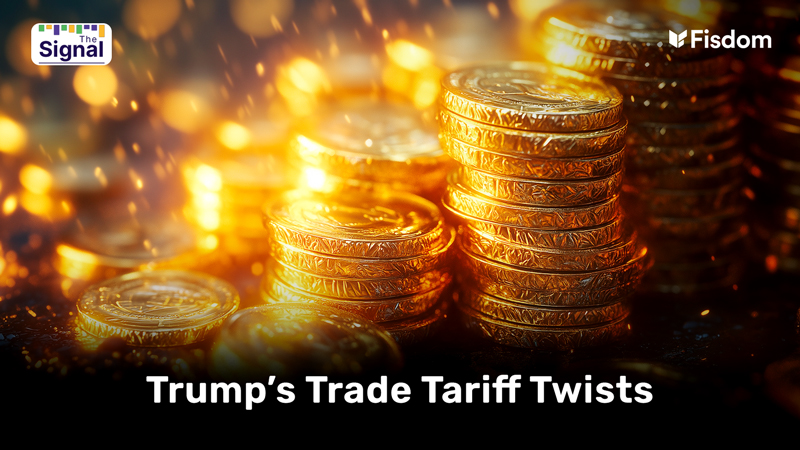
US President Donald Trump’s recent announcement of reciprocal tariffs has sent ripples across global trade markets, with India being one of the key economies under scrutiny. The policy, which aligns US import duties with those imposed by other nations, could reshape trade relationships, impact manufacturing, and influence financial markets. While India is not currently on the immediate tariff list, its historically high import duties compared to the US put it at risk of future levies.
Potential Impact on Indian Trade
India’s export-oriented industries, particularly pharmaceuticals, automobiles, and IT services, could face challenges if reciprocal tariffs are imposed. With the US being a major trade partner, any increase in duties could reduce export competitiveness and squeeze margins for Indian firms reliant on the American market. On the flip side, US importers may look for alternative sourcing destinations, creating opportunities for India as a beneficiary of the ‘China plus one’ strategy. However, whether India can capitalize on this depends on multiple factors, including production capabilities, trade negotiations, and the evolving global economic environment.
Manufacturing and Global Supply Chain Shifts
One of the broader consequences of the tariff imposition is the potential shift in global supply chains. With China, Mexico, and Canada facing higher US tariffs, India could emerge as a favorable alternative for American companies seeking lower-cost manufacturing bases. However, this transition is far from guaranteed. India still depends heavily on imported components, and any disruption in supply chains could lead to inflationary pressures on manufacturing costs. Additionally, global companies may hesitate to make large-scale investments in uncertain trade environments.
Currency Volatility and Inflation Risks
The trade tensions have already fueled volatility in global currency markets, strengthening the US dollar. This has weakened emerging market currencies, including the Indian rupee, which has depreciated against the dollar in recent months. A weaker rupee increases import costs, contributing to inflationary risks in India. However, a silver lining is that it could make Indian exports more attractive globally. The net effect will depend on the Reserve Bank of India’s (RBI) ability to manage currency stability while balancing inflation concerns.
Foreign Fund Flows and Market Sentiment
Foreign investors have been net sellers in Indian equity markets, offloading significant amounts amid rising global uncertainties. If the dollar continues to strengthen, capital outflows from emerging markets could persist, further weighing down stock valuations. Retail investors have so far provided support to Indian equities, but sustained pressure on earnings growth and reduced government investment spending could dampen sentiment. Market resilience will largely depend on domestic investor participation and corporate earnings recovery.
A Window for Diplomatic and Trade Negotiations
Despite the risks, India’s exclusion from the immediate tariff list presents an opportunity to strengthen trade relations with the US. Diplomacy will play a key role in navigating these changes, and New Delhi could leverage this moment to negotiate favorable terms for Indian exporters. A proactive trade strategy, coupled with internal policy reforms to enhance manufacturing and exports, could position India advantageously in a shifting global trade order.
Conclusion
Trump’s reciprocal tariff policy has introduced new complexities to global trade dynamics, with both risks and opportunities for India. While the immediate impact on Indian markets includes currency fluctuations, foreign fund outflows, and potential cost pressures, there is also a chance for India to emerge stronger if it strategically navigates trade realignments. The coming months will be crucial in determining how India adapts to these evolving economic challenges.
Market this week
| 10th Feb 2025 (Open) | 14h Feb 2025 (Close) | %Change | |
| Nifty 50 | ₹ 23,544 | ₹ 22,929 | -2.6% |
| Sensex | ₹ 77,789 | ₹ 75,939 | -2.4% |
Source: BSE and NSE
- The Indian market snapped a two-week gaining streak and posted its biggest weekly losses in two months. Volatility remained high due to uncertainty over Trump’s tariff policies, mixed corporate earnings, relentless foreign institutional investor (FII) selling, and rupee depreciation against the dollar.
- All sectoral indices ended the week in negative territory. The Nifty Realty index recorded the steepest decline, falling 9.4%. The Nifty Media index dropped 8%, while the Nifty Energy index declined 7%. The Nifty Auto index lost 6%, the Nifty Pharma index fell 5.7%, and the Nifty PSU Bank index shed 5.2%.
- Foreign institutional investors (FIIs) continued their selling spree, offloading equities worth ₹19,004.03 crore during the week. On the other hand, domestic institutional investors (DIIs) provided some support, purchasing equities worth ₹18,745.02 crore.
- For the month so far, FIIs have sold equities worth ₹29,183.43 crore, while DIIs have bought equities worth ₹26,019.07 crore. Despite domestic buying, foreign outflows have exerted downward pressure on.
Weekly Leaderboard
| NSE Top Gainers | NSE Top Losers | ||||
| Stock | Change (%) | Stock | Change (%) | ||
| Bharti Airtel | ▲ | 2.4% | Eicher Motors | ▼ | -12.5% |
| Bajaj Finserv | ▲ | 2.4% | Bharat Electronics | ▼ | -9.6% |
| Britannia Industries | ▲ | 1.4% | Hero MotoCorp | ▼ | -9.6% |
| Kotak Mahindra Bank | ▲ | 1.2% | Mahindra & Mahindra | ▼ | -8.0% |
| ICICI Bank | ▲ | 0.3% | Adani Enterprises | ▼ | -8.0% |
Source: BSE
Stocks that made the news this week:
- Shares of Indian pharmaceutical companies declined on February 14 amid concerns over potential US tariffs on the sector. The sell-off followed US President Donald Trump’s announcement that he would impose tariffs on foreign cars, semiconductors, and pharmaceuticals as part of his broader reciprocal tariff strategy. Major drugmakers such as Dr Reddy’s Laboratories, Sun Pharma, Lupin, Cipla, Zydus Life, and Aurobindo Pharma fell between 1-4% as investors worried about the impact on margins and pricing competitiveness in the US market.
- Real estate stocks also faced heavy selling pressure, with Phoenix Mills leading the decline, dropping 3.3% to approach a 52-week low. Raymond and Godrej Properties fell over 3% each, with Godrej Properties down more than 32% over the past six months. Other realty firms, including Oberoi Realty, Mahindra Lifespace Developers, Sobha, Prestige Estates, and DLF, also saw declines, contributing to the broader Nifty Realty index’s weakness.
- Nuclear energy-related stocks tumbled by up to 6% after Prime Minister Narendra Modi and US President Donald Trump announced plans to advance a long-pending civil nuclear agreement involving American-designed reactors in India. Companies such as BHEL, L&T, Kirloskar Brothers, KSB, Walchandnagar Industries, and Power Mech Projects were hit amid uncertainty over how Indian firms would fit into the nuclear energy value chain. While the deal aims to boost India’s energy security through technology transfer and localisation, analysts remain cautious about its long-term impact.














